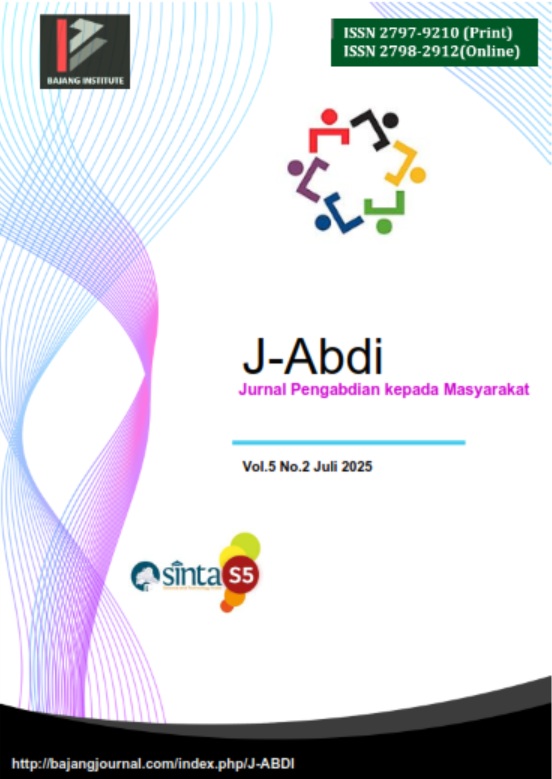PEMANTAUAN IMT DAN KEBERSIHAN DIRI PADA ANAK USIA DINI DI PAUD MELATI III DESA OELOMIN KABUPATEN KUPANG
DOI:
https://doi.org/10.53625/jabdi.v5i2.10744Keywords:
Monitoring, BMI, Hygiene, SelfAbstract
Children enrolled in the Early Childhood Education (PAUD) program are children aged between two and six years, also known as preschoolers. Growth in children is a quantitative physical change, namely an increase in the size and number of cells and body tissues, which causes an increase in height, weight, and other physical changes in children. Monitoring children's growth is very important to identify nutritional problems because if a child's growth is not monitored properly, their nutritional status will not be properly monitored and if the child experiences abnormalities, it will not be able to be identified and treated early. A child's BMI status can provide an overview of the nutritional status of early childhood with classifications of underweight, normal nutrition (normal weight), at risk of overweight, and overnutrition (obesity). Nutritional problems involve many factors, one factor that can also influence is personal hygiene. Personal hygiene is the cleanliness and health of individuals aimed at preventing the emergence of diseases in oneself and others, both physically and psychologically. Personal hygiene includes the care of the scalp and hair, eyes, nose, ears, toenails and fingers, skin, and genital area. This underlies the need to monitor BMI and personal hygiene in children. The goal of this activity was to obtain an overview of the students' nutritional and personal hygiene status. The methods used were direct measurement of weight and height, observation of personal hygiene, and subsequent provision of information on how to maintain personal hygiene. The results showed that most students had good nutritional status, maintained good personal hygiene, and were very cooperative
References
Aryani A, Azmi LDD, Widiyono W, Herawati VD, Indriyati I, Nurhayadi N, et al. Deteksi Pertumbuhan: Pengukuran Tinggi Badan, Berat Badan Dan Indeks Massa Tubuh Pada Anak Prasekolah. Bhakti Sabha Nusant. 2023;2(2):119–23.
Yugan E, Amir Y, Fitri A. Gambaran aktivitas fisik dengan Indeks Massa Tubuh (IMT) pada anak usia sekolah. FLORONA J Ilm Kesehat. 2023;2(2):104–10.
Herawati HD, Rahayu HK, Triastanti RK, Rusiyono R. Pencegahan Malnutrisi pada Anak Prasekolah melalui Pelatihan Pengukuran Status Gizi pada Guru PAUD. Media Karya Kesehat. 2023;6(1):157–68.
Kesehatan K. Permenkes Nomor 2 Tahun 2020 Tentang Standar Antropometri. Permenkes [Internet]. 2020;53(1):1–9. Available from: http://dx.doi.org/10.1016/j.biochi.2015.03.025%0Ahttp://dx.doi.org/10.1038/nature10402%0Ahttp://dx.doi.org/10.1038/nature21059%0Ahttp://journal.stainkudus.ac.id/index.php/equilibrium/article/view/1268/1127%0Ahttp://dx.doi.org/10.1038/nrmicro2577%0Ahttp://
BKPK K. SSGI 2024: Prevalensi Stunting Nasional Turun Jadi 19,8%, Capai Angka di Bawah Proyeksi Bappenas. Stunting.go.id [Internet]. 2025;2023–5. Available from: https://stunting.go.id/ssgi-2024-prevalensi-stunting-nasional-turun-jadi-198-capai-angka-di-bawah-proyeksi-bappenas/
Timur BPSNT. Data BPS [Internet]. 2021. 2024. Available from: https://ntt.bps.go.id/id/statistics-table/2/MTU3MiMy/jumlah-dan-persentase-balita-wasting-menurut-kabupaten-kota.html
JoshSilalahi, Verarica, Ronasari Mahaji Putriua B. Personal hygiene pada anak SD Negeri Merjosari 3. JAPI (Jurnal Akses Pengabdi Indones. 2018;2(2):111.
Erna Safitri, Sela Safitria, Wada Islami, Ade Rahma Azizah, Intan Safitri, Maulidar Maulidar, et al. Edukasi Kebersihan Diri (Personal Hygiene) pada Anak untuk Meningkatkan Kebersihan Diri Anak di SMPN 1 Seuneuddon. SEWAGATI J Pengabdi Masy Indones. 2025;4(2):13–9.














